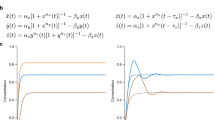Abstract
Delay-differential equations are commonly used to model genetic regulatory systems with the delays representing transcription and translation times. Equations with delayed terms can also be used to represent other types of chemical processes. Here we analyze delayed mass-action systems, i.e. systems in which the rates of reaction are given by mass-action kinetics, but where the appearance of products may be delayed. Necessary conditions for delay-induced instability are presented in terms both of a directed graph (digraph) constructed from the Jacobian matrix of the corresponding ODE model and of a species-reaction bipartite graph which directly represents a chemical mechanism. Methods based on the bipartite graph are particularly convenient and powerful. The condition for a delay-induced instability in this case is the existence of a subgraph of the bipartite graph containing an odd number of cycles of which an odd number are negative.
Similar content being viewed by others
References
Bélair J., Campbell S.A. and van den Driessche P. (1996). Frustration, stability, and delay-induced oscillations in a neural network model. SIAM J. Appl. Math. 56: 245–255
Bellman R.E. and Cooke K.L. (1963). Differential Difference Equations. Academic Press, New York
Biggs N. (1989). Discrete Mathematics. Oxford Science, Oxford
Bliss R.D., Painter P.R. and Marr A.G. (1982). Role of feedback inhibition in stabilizing the classical operon. J. Theor. Biol. 97: 177–193
Buchholtz F. and Schneider F.W. (1987). Computer simulation of T3/T7 phage infection using lag times. Biophys. Chem. 26: 171–179
Campbell S.A. (2001). Delay independent stability for additive neural networks. Diff. Eqs. Dyn. Syst. 9: 115–138
Elowitz M.B. and Leibler S. (2000). A synthetic oscillatory network of transcriptional regulators. Nature 403: 335–338
Epstein I.R. (1990). Differential delay equations in chemical kinetics: some simple linear model systems. J. Phys. Chem. 92: 1702–1712
Epstein I.R. and Luo Y. (1991). Differential delay equations in chemical kinetics. Nonlinear models: The cross-shaped phase diagram and the Oregonator. J. Chem. Phys. 95: 244–254
Fiedler M. (1986). Special Matrices and their Applications in Numerical Mathematics. Kluwer, Dordrecht
Gantmakher F.R. (1959). Applications of the Theory of Matrices. Interscience Publishing, New York
Goldbeter A. (1995). A model for circadian oscillations in the Drosophila period protein (PER). Proc. R. Soc. Lond. B 261: 319–324
Gupta A. and Markworth A.J. (2000). The Portevin-Le Châtelier effect: A description based on time delay. Phys. Status Solidi B 217: 759–768
Hale J. and Verduyn Lunel S.M. (1993). Introduction to Functional Differential Equations. Springer, New York
Hofbauer J. and So J.W.-H. (2000). Diagonal dominance and harmless off-diagonal delays. Proc. Amer. Math. Soc. 128: 2675–2682
Jacquez J.A. and Simon C.P. (1993). Qualitative theory of compartmental systems. SIAM Rev. 35: 43–79
Laidler K.J. (1987). Chemical Kinetics, 3rd edn. Harper & Row, New York
Lancaster P. and Tismenetsky M. (1985). The Theory of Matrices. Academic, Orlando
MacDonald N. (1989). Biological Delay Systems: Linear Stability Theory. Cambridge University Press, Cambridge
Mahaffy J.M. (1984). Cellular control models with linked positive and negative feedback and delays. I. The models. J. Theor. Biol. 106: 89–102
Mahaffy J.M. and Pao C.V. (1984). Models of genetic control by repression with time delays and spatial effects. J. Math. Biol. 20: 39–57
Mincheva, M., Roussel, M.R.: Graph-theoretic methods for the analysis of chemical and biochemical networks. I. Multistability and oscillations in ordinary differential equation models doi:10.1007/s00285-007-0099-1
Monk N.A.M. (2003). Oscillatory expression of Hes1, p53 and NF-κB driven by transcriptional time delays. Curr. Biol. 13: 1409–1413
Nazarenko V.G. and Reich J.G. (1984). Theoretical study of oscillatory and resonance phenomena in an open system with induction of enzyme by substrate. Biomed. Biochim. Acta 43: 821–828
Pieroux D. and Mandel P. (2003). Bifurcation diagram of a complex delay-differential equation with cubic nonlinearity. Phys. Rev. E 67: 056213
Pinney J.W., Westhead D.R. and McConkey G.A. (2003). Petri net representations in systems biology. Biochem. Soc. Trans. 31: 1513–1515
Pomerening J.R., Kim S.Y. and Ferrell Jr. J.E. (2005). Systems-level dissection of the cell-cycle oscillator: Bypassing positive feedback produces damped oscillations. Cell 122: 565–578
Poole R.K. (2005). Nitric oxide and nitrosative stress tolerance in bacteria. Biochem. Soc. Trans. 33: 176–180
Roussel C.J. and Roussel M.R. (2001). Delay differential equations and the model equivalence problem in chemical kinetics. Phys. Can. 57: 114–120
Roussel M.R. (1996). The use of delay differential equations in chemical kinetics. J. Phys. Chem. 100: 8323–8330
Roussel M.R. (1998). Approximating state-space manifolds which attract solutions of systems of delay-differential equations. J. Chem. Phys. 109: 8154–8160
Rubinow S.I. (1975). Some mathematical problems in biology. Bull. Amer. Math. Soc. 81: 782–794
Saaty T.L. (1981). Modern Nonlinear Equations. Dover, New York
olde Scheper T., Klinkenberg D., Pennartz C. and van Pelt J. (1999). A mathematical model for the intracellular circadian rhythm generator. J. Neurosci. 19: 40–47
Smolen P., Baxter D.A. and Byrne J.H. (2001). Modeling circadian oscillations with interlocking positive and negative feedback loops. J. Neurosci. 21: 6644–6656
Stépán G. (1989). Retarded Dynamical Systems: Stability and Characteristic Functions. Longman, New York
Wang R., Jing Z. and Chen L. (2005). Modelling periodic oscillations in gene regulatory networks by cyclic feedback systems. Bull. Math. Biol. 67: 339–367
Zevedei-Oancea I. and Schuster S. (2005). A theoretical framework for detecting signal transfer routes in signalling networks. Comput. Chem. Eng. 29: 597–617
Author information
Authors and Affiliations
Corresponding author
Additional information
This work was funded by the Natural Sciences and Engineering Research Council of Canada.
Rights and permissions
About this article
Cite this article
Mincheva, M., Roussel, M.R. Graph-theoretic methods for the analysis of chemical and biochemical networks. II. Oscillations in networks with delays. J. Math. Biol. 55, 87–104 (2007). https://doi.org/10.1007/s00285-007-0098-2
Received:
Revised:
Published:
Issue Date:
DOI: https://doi.org/10.1007/s00285-007-0098-2




